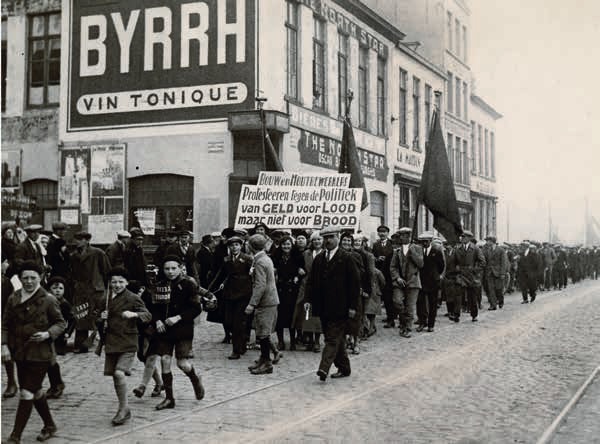The Legislative Power of the Belgian Construction Worker
Exploring a Forgotten History (1909–1939)
DOI:
https://doi.org/10.48003/knob.124.2025.3.864Downloads

Abstract
Although no architectural project is built without construction workers, labourers remain woefully underrepresented in architectural and construction history. By tracing the emergence and development of the Algemene Centrale van de Bouw, the socialist construction workers’ union in Belgium, this article seeks to address that gap. It aims to move beyond the conventional emphasis on the relationship between workers and construction practice and to demonstrate how construction workers also had a significant impact on the legislative framework of the Belgian construction sector – far beyond the construction site itself.
The article focuses on the union’s two main priorities: the struggle for fair wages and for improved safety on construction sites. Initially through strikes and later through more institutionalized negotiations, the organization succeeded in securing and protecting construction workers’ wages, while also helping to shape the development of safety regulations on site through bargaining and media campaigns. Furthermore, the union skilfully navigated the complex legal landscape of the Belgian construction sector. By strategically leveraging collective labour agreements and public procurement documents, it promoted alternative forms of regulation. This allowed changes to be implemented without relying on the often cumbersome procedures of formal legislation, granting the union a tangible influence on construction practices.
These legal instruments also enabled the union to respond to the sweeping technological changes and new building materials that were entering the construction sector at the time. They valorised the new labour risks and technical skills these innovations entailed by incorporating them into improved wage conditions. In doing so, construction workers –too often overlooked in architectural, construction and social history – asserted their legislative power and laid the essential groundwork for improved wages and safety in the construction sector during the post-war development of the Belgian welfare state.
References
G. Deneckere, ‘De algemene staking van 1936. Wetten en praktische bezwaren tegen een volksfront’, Cahiers d'Histoire de la seconde guerre mondiale XVII (1995) 1, 103-128; L. Peiren, ‘De staking van 1936 in de Grand Bazar van Antwerpen’, Brood en Rozen 20 (2020), 43-52. M. Schoups, Meesters van de Straat: Strijd om de publieke ruimte in Antwerpen, 1884-1936, Amsterdam, 2024.
E. Gerard, De Christelijke Arbeidersbeweging in België: 1891- 1991, Leuven 1991; J. Deferme, Uit de ketens van de vrijheid: het debat over de sociale politiek in België, Leuven 2007; J. Brepoels, Wat zoudt gij zonder ’t werkvolk zijn? De geschiedenis van de Belgische arbeidersbeweging 1830-2015, Leuven 2015.
Dezelfde vaststelling werd bijvoorbeeld gemaakt binnen de Britse context in: C. McGuire, L. Clarke en Christine Wall, ‘Battles on the Barbican: the Struggle for Trade Unionism in the British Building Industry, 1965–7’, History Workshop Journal 75. (2013) 1, 33–57. In Nederland bestond er enige aandacht voor het onderwerp, maar recente publicaties ontbreken: zie bijvoorbeeld: H. Searing, ‘Betondorp: Amsterdam's Concrete Garden Suburb’, Assemblage 3 (1987), 108-143.
J. Summerson, ‘What Is the History of Construction?’, Construction History 1 (1985), 1.
J. Dobbels, Building a Profession : A History of General Contractors in Belgium (1870 - 1970), Brussel 2022; A. Saint, Architect and Engineer : A Study in Sibling Rivalry, New Haven (Conn.) 2007; I. Bertels, Building the City, Antwerp 1819-1880, Antwerpen, 2006.
L. Clarke, Building Capitalism : Historical Change and the Labour Process in the Production of the Built Environment, London, 1992; A. Forty, Concrete and Culture : A Material History, London 2012; C. Wall, An Architecture of Parts : Architects, Building Workers and Industrialisation in Britain 1940-1970, London 2013; J. Paskins, Paris under Construction : Building Sites and Urban Transformation in the 1960s, London 2017.
J. Angillis, Building in a Transforming Society: An Exploration of the Dynamic Interplay between Construction Workers and Contractors in Post-War Belgium 1944-1980, Antwerpen 2024.
Hierbij is het belangrijk te onderlijnen dat sociaal overleg in België een wettelijke status heeft, doordat collectieve arbeidsovereenkomsten niet louter sectorale overeenkomsten zijn, maar ook officieel in het staatsblad gepubliceerd worden.
S. Ferro, e.a., Architecture from below : An Anthology, London 2024. Voor het collectief Who Builds Your Architecture (WBYA), zie: http://whobuilds.org/.
Zie o.m.: S. Agnoletto, The Italians Who Built Toronto: Italian Workers and Contractors in the City’s Housebuilding Industry, 1950–1980, Oxford 2014; C. Wall, e.a., Building the Barbican, 1962-1982 : Taking the Industry out of the Dark Ages, London 2014.
Enkele belangrijke uitzonderingen hierop zijn: M. Woods, From Craft to Profession : The Practice of Architecture in Nineteenth-Century America, Berkeley 1999; R. Carvais, ‘For a Comparative Study of Construction Laws’, in: R. Carvais, e.a. (red.), Nuts & Bolts of Cunstruction History, Parijs 2012, 475–487; S. Pinto, ‘Behaviours and Procedures Used by Construction Agents of Ordinary Buildings in Portugal during the Late Middle Ages and Early Modern Period’, Construction History 33 (2018) 1, 49–68; D. Keuning en P. Bente, ‘Wet en Rede: Het auteursrecht van architecten in historisch perspectief’, Bulletin KNOB 124. (2025) 1, 25–44. S. De Nys-Ketels en D. De ruysscher, ‘Building the law: law-making and lobbying in Belgium’s construction sector (c. 1890 – c. 1940)’, Tijdschrift voor Rechtsgeschiedenis 93 (2025) 1-2, 237–263.
J. Castermans, ‘Evolutie van het begrip bouwvergunning in de Belgische wetgeving’, Jura Falconis, 7 (1970–1971), 313–325. R. Carvais, ‘Le statut juridique de l’entrepreneur de bâtiment dans la France moderne’, Revue historique de droit français et étranger, 74 (1996), 221-252; S. Schoenmaekers, The regulation of architects in Belgium and the Netherlands: A comparative analysis, Antwerpen 2010. C.H. Bom, et al. (red.), Le droit de l’aménagement du territoire et de l’urbanisme, 50 ans après la loi organique, Liège 2013.
R. Carvais, ‘Plaidoyer pour une histoire humaine et sociale de la construction’, in: A. Becchi, R. Carvais en J. Sakarovitch (red.), Construction History: Survey of a European Building Site, Parijs 2018, 1068.
J. Angillis, ‘Antwerpse Bouwwerven Belicht. De Naoorlogse Bouwwerf Als Een Veelzijdige Afspiegeling van de Evoluerende Bouwpraktijk’, Stadsgeschiedenis 17 (2022) 1, 39–54; R. Fivez, ‘Unfortunately, the Toll Is High for Some of Your Blacks’: Moments of Crisis in the Belgian Congo’s Construction Industry’, in: S. Holzer, e.a. (red.), Construction Matters: Proceedings of the 8ICCH, Zurich 2024, 1101–1109; S. Melsens, ‘(De)Constructing Gender? Women Laborers and Building Site Photography in Western India, 1850–1990’, in: S. Holzer, e.a. (red.), Construction Matters: Proceedings of the 8ICCH, Zurich 2024, 1093–1100.
In een verzuild land als België bestond uiteraard ook een Chirstelijke bouwvakbond, de Christelijke Centrale der Houtbewerkers en Bouwvakarbeiders. Deze verenigde zich echter nationaal pas in de jaren 1930 en had minder impact op de toenmalige bouwsector. Zie Angillis 2024 (noot 6), 30-31.
AMSAB-ISG, MAD11645, Centrale Vereniging der Bouwwerkers van België, Standregelen, Brussel 1909,.
AMSAB-ISG, 158/1.A/00007, Algemene Centrale van Bouw, Ameublement en Gemengde Vakken, Verslagen voorgelegd aan het Nationaal Kongres van Brussel, Brussel 1925, 33.
AMSAB-ISG, 158/1.A/00003, Verslag van de Centrale Vereniging der Bouwerkers van België, Brussel 1912, 29.
AMSAB-ISG, 158/1.A/00006, Algemene Centrale van Bouw, Ameublement en Gemengde Vakken, Verslagen voorgelegd aan het Nationaal Kongres van Brussel, Brussel 1924, 93.
AMSAB-ISG, 158/1.A/00005, Algemene Centrale van Bouw, Ameublement en Gemengde Vakken, Verslagen voorgelegd aan het Nationaal Kongres van Brussel, Brussel 1922, 4-5.
Belangrijk hierbij is dat deze sociale verbetering zich telkens toespitsten op bouwvakkers met het statuut van werknemers. Veel informele relaties in de bouw werk(t)en echter via onderaanneming, waarop het wetgevend kader per definitie veel minder vat had. AMSAB-ISG, 158/1.A/00005, Algemene Centrale van Bouw, Ameublement en Gemengde Vakken, Verslagen voorgelegd aan het Nationaal Kongres van Brussel, Brussel 1922, 4-5.
AMSAB-ISG, 158/1.A/00007, Algemene Centrale van Bouw, Ameublement en Gemengde Vakken, Verslagen voorgelegd aan het Nationaal Kongres van Brussel, Brussel 1925, 43.
AMSAB-ISG, 158/1.A/00006, Algemene Centrale van Bouw, Ameublement en Gemengde Vakken, Verslagen voorgelegd aan het Nationaal Kongres van Brussel, Brussel 1924, 48; AMSAB-ISG, 158/1.A/00007, Algemene Centrale van Bouw, Ameublement en Gemengde Vakken, Verslagen voorgelegd aan het Nationaal Kongres van Brussel, Brussel 1925, 14-17.
AMSAB-ISG, 158/1.A/00007, Algemene Centrale van Bouw, Ameublement en Gemengde Vakken, Verslagen voorgelegd aan het Nationaal Kongres van Brussel, Brussel 1925, 43.
Deneckere 1994 (noot 1), 4.
AMSAB-ISG, 158/1.A/00006, Algemene Centrale van Bouw, Ameublement en Gemengde Vakken, Verslagen voorgelegd aan het Nationaal Kongres van Brussel, Brussel 1924, 53.
AMSAB-ISG, 158/1.A/00007, Algemene Centrale van Bouw, Ameublement en Gemengde Vakken, Verslagen voorgelegd aan het Nationaal Kongres van Brussel, Brussel 1925, 11.
Volgens Patricia Van der Eeckhout zou er reeds in 1908 een éénmalig CAO hebben bestaan in de havenstad. Dit CAO kon niet getraceerd worden, en de impact ervan is dus onduidelijk, en ook zij haalt het verdrag van 1928 aan als kantelpunt. P. Van den Eeckhout, ‘Les salaires de la construction de 1885 à 1990’, Les Cahiers de la Fonderie 19 (1995), 2-11.
AMSAB-ISG, 158/1.A/00010, Algemene Centrale van Bouw, Ameublement en Gemengde Vakken, Verslagen voorgelegd aan het Nationaal Kongres van Brussel, Brussel 1928, 60.
Wet zoals gestipuleerd in: Arbeidsovereenkomst voor het Bouwbedrijf in Antwerpen en Omgeving, 1928, AMSAB-ISG, 158/4.A/00699.
J.P. Nandrin, ‘Les premiers pas de l’inspection du travail’, Les Cahiers de la Fonderie 19 (1995), 39-41.
AMSAB-ISG, 158/1.A/00008, Algemene Centrale van Bouw, Ameublement en Gemengde Vakken, Verslagen voorgelegd aan het Nationaal Kongres van Brussel, Brussel 1926, 44.
“In ‘t bouwbedrijf”, De Ontvoogding 16(12), 1927; AMSAB-ISG, 158/1.A/00008, Algemene Centrale van Bouw, Ameublement en Gemengde Vakken, Verslagen voorgelegd aan het Nationaal Kongres van Brussel, Brussel 1926, 46-49.
Het gevolg van deze klacht kon niet getraceerd worden. AMSAB-ISG, 158/1.A/00009, Algemene Centrale van Bouw, Ameublement en Gemengde Vakken, Verslagen voorgelegd aan het Nationaal Kongres van Brussel, Brussel 1927, 62-63.
AMSAB-ISG, 158/1.A/00010, Algemene Centrale van Bouw, Ameublement en Gemengde Vakken, Verslagen voorgelegd aan het Nationaal Kongres van Brussel, Brussel 1928, 56.
Koninkrijk België, Algemeen Kohier van Lasten, Brussel 1928, 27.
Forty 2012 (noot 5), 226.
E-H. Heine en C. Rauhut (red.), Producing Non-Simultaneity Construction Sites as Places of Progressiveness and Continuity, Milton Park 2018.
A. De Coss-Corzo, ‘The Sensorial Management of Water in Mexico City’, Roadsides 006 (2021), 7-14; Wall 2013 (noot 5). Bovendien bracht betonbouw ook vaak bijkomende eisen voor geschoolde arbeid voor afwerking en pleisterwerk met zich mee: H. Searing, ‘Betondorp: Amsterdam's Concrete Garden Suburb’, Assemblage 3 (1987), 108-143.
AMSAB-ISG, 158/4.A/00699, Arbeidsovereenkomst voor het Bouwbedrijf in Antwerpen en Omgeving, 1928.
AMSAB-ISG, 158/4.A/00699 ,Arbeidsovereenkomst voor het Bouwbedrijf in Antwerpen en Omgeving, 1928.
Zoals Figuur 9 illustreert, lag met 7,35 en 7,5 BEF het uurloon in Antwerpen en Brussel inderdaad gemiddeld zo’n 1 à 2 BEF hoger dan in veel andere, kleinere gemeentes.
AMSAB-ISG, 158/4.A/00699, Arbeidsovereenkomst voor het Bouwbedrijf in Antwerpen en Omgeving, 1928.
M-J. Willaert, ‘Chantier Invisible. Labour Conditions of the Brusselisation (1960-1980)’, Ongepubliceerde Master Thesis, Gent 2025.
A.L. Stoler, ‘Colonial archives and the arts of governance’, Archival Science, 2 (2002) 1, 90.
Published
How to Cite
Issue
Section
Articles
License
Copyright (c) 2025 Simon De Nys-Ketels

This work is licensed under a Creative Commons Attribution 4.0 International License.





